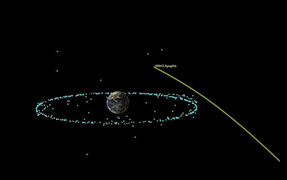The transformative technology of laser/free-space optical communications

In an era dominated by global connectivity in which internet accessibility is the cornerstone of advancement and innovation, laser communications (lasercom), also known as free-space optical (FSO) or wireless optical communications, has emerged as a cutting-edge technology that provides data transmission rates comparable to fiber optics at 100s of Gbps. With the ever-growing demand for high-speed internet and data transmission across the globe, lasercom provides numerous advantages beyond ultra-high bandwidth. These include low latency, unregulated spectrum, and immunity to radio frequency (RF) interference.
Lasercom technology challenges include a requirement for highly precise laser beam pointing, situations of cloud-cover and adverse weather outage, and atmospheric turbulence effects that hamper ground-to-satellite links. Overcoming these hurdles necessitates further exploration in areas such as uplink adaptive-optics, atmosphere modeling, and error-correcting codes that can effectively mitigate atmospheric scintillation effects.
Additional challenges include an absence of readily available satellite-compatible components, and an insufficient number of ground stations, although the latter is gradually improving. Furthermore, the existence of multiple laser communication standards, such as SDA, ESTOL, and CCSDS, are available to manufacturers in this domain.
The primary advantage of lasercom over RF/microwave communications arises from its significantly narrower beam divergence, a feature driven by the physics of wavelength proportionality. Consequently, a significantly higher portion of the transmitted signal reaches the intended receiver in comparison to RF/microwave communications.
Commercial initiatives such as SpaceX’s Starlink and Amazon’s Kuiper involve thousands of satellites either already operational or planned for low-Earth orbit (LEO), alongside a few government satellite constellations like that of the Space Development Agency (SDA). Combined, they have helped to rapidly mature lasercom technology. These satellite networks have helped create baseline laser links operating at near-infrared wavelengths for their intersatellite connectivity, and for certain satellite-to-ground communications. By leveraging lasercom for signal transmission between satellites and reducing reliance on ground stations for data relay, these endeavors hold the promise of providing high-speed internet access to remote and underserved areas worldwide. The commercial efforts aim to bridge the digital divide, fostering economic growth.
While the primary consumers of flight optical transceivers are in the process of developing their own hardware, the market for essential components—laser transmitters, power amplifiers, fast-steering mirrors, quadrant detectors or focal-plane arrays for acquisition and tracking, as well as subsystems including optical assemblies (telescopes), coarse-pointing assemblies, and modems—could be substantial. What’s more, the market size may be augmented by government satellite constellations in the US and Europe, with thousands of terminals expected. In total, the estimated value of the burgeoning market for satellite laser communication payloads is approximately $1 billion annually.
Starlink reportedly has more than 10,000 lasercom terminals in space—each capable of 100 Gbps data-rate—facilitating inter-satellite connections within its extensive constellation of satellites. In 2022, the Terabyte Infra-Red Delivery (TBIRD) lasercom payload, roughly the size of a tissue box onboard a small cubesat developed at Massachusetts Institute of Technology for National Aeronautics and Space Administration, demonstrated 200 Gbps links to ground stations in California.
This remarkable advancement represents a 200 times greater bandwidth than typical internet speeds in urban areas and surpasses traditional RF links used in satellite communication by more than 1,000 times. It is worth noting that the aperture diameter of lasercom systems is about one-tenth that of conventional RF/microwave links, for instance, 10 cm versus 100 cm. Tesat-Spacecom has been supplying operational intersatellite, satellite-to-ground, and Earth-to-space links for several years. Other prominent players include Mynaric, CACI, Skyloom, and Embryonics, alongside several other manufacturers.
In late 2023, NASA’s Jet Propulsion Laboratory conducted the Deep-Space Optical Communications (DSOC) link, marking the first successful establishment of laser communication links from deep-space locations. DSOC endeavors to transform interplanetary communication capabilities by facilitating rapid data transfer between spacecraft probes exploring planets or celestial bodies in the outer reaches of our solar system, and Earth-based stations. The primary objective, conducted with a payload aboard the Psyche satellite, is to achieve data rates approximately two orders of magnitude faster than those attainable with RF/microwave communication links over distances of up to three astronomical units, which extend beyond the farthest point between Earth and Mars. This milestone would follow that of the Lunar Laser Communications Demonstration project, which established laser communication links between Earth and the Moon.
Aerial and terrestrial laser communication links hold significant appeal for civilian and tactical purposes due to their covert nature and minimal probability of interception and detection. Combined with an ability to achieve exceptionally high data rates, they would be invaluable assets in the communication toolbox.
An example of such a high-speed commercial offering, developed by Viasat, is a transceiver capable of delivering 40 Gbps over a range of 40 km. It was designed for terrestrial, ship-to-ship, ship-to-shore, and ground-to-air tactical links. The transceiver features auto-tracking functionality and is suitable for deployment on fixed assets, tall masts, and vehicles on-the move. A notable decrease in the cost of multi-Gbps optical transceivers operating over multi-km ranges will make them more conducive for use in cell tower backhaul, anticipating a substantial surge in demand volume.
Present-day lasercom/FSO technology has moved into operational use cases, and it represents a paradigm shift in the way widely dispersed nodes, spanning distances from kilometers to interplanetary scales, are linked. The projects mentioned exemplify the transformative potential of lasercom technology, offering effective solutions to address the growing demand for global high-bandwidth connectivity. By harnessing the power of light, the lasercom technology paves the groundwork for a future that is ideally interconnected, sustainable, secure, inclusive, and equitable while opening new frontiers in space exploration.
Hamid Hemmati is CTO and Vice President of Viasat, a global communications company connecting homes, businesses, and governments with satellite internet connectivity solutions.



